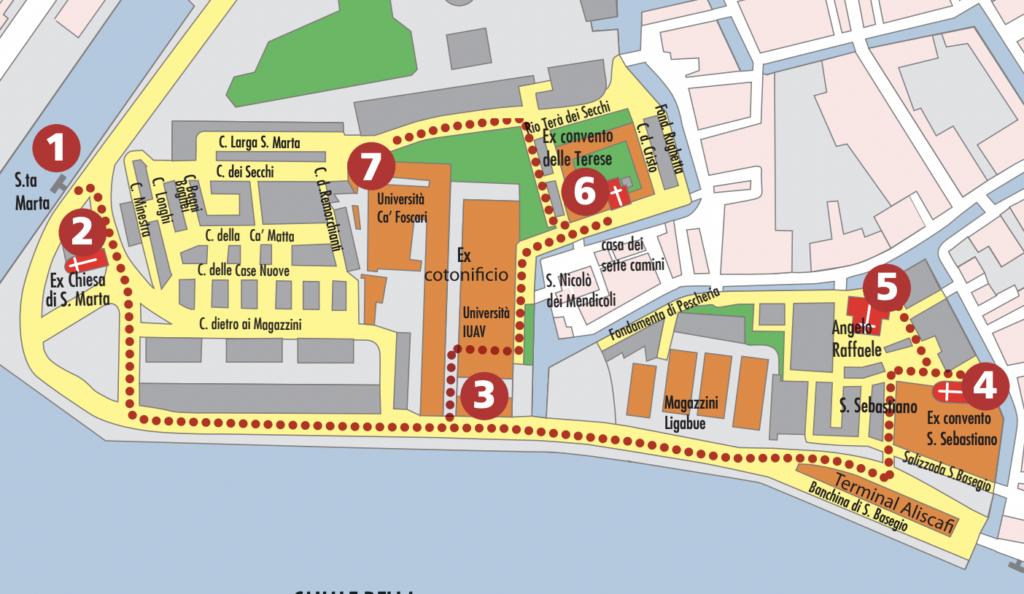Accademia di Belle Arti di Venezia
Auditorium ex-Chiesa di Santa Marta
Sestiere Dorsoduro
VENEZIA
The former Church of Santa Marta, dating back to the 14th century, was converted into a congress center after its restoration. It currently houses the Venice Academy of Fine Arts.
The former church is owned by the Northern Adriatic Sea Port System Authority, which has entered into an agreement with the Academy of Fine Arts of Venice to allow the Academy to use the space for teaching and events.
Inside the church, there is an auditorium designed by the architect Vittorio De Feo, considered one of the most interesting examples of architectural reconversion in Venice. The auditorium occupies the former sacred building annexed to the convent of the same name.
The Santa Marta area occupies the western end of the city, where ancient settlements have been replaced by working-class neighborhoods and buildings constructed between the nineteenth and twentieth centuries. The area is characterized by the presence of significant buildings in terms of industrial archeology and of great impact in the Venetian context: from the gasometer plants to those of the aqueduct, from the large buildings of the former Cotonificio Veneziano to the former Magazzini Ligabue. Over the years, many of these buildings have been transformed into university buildings, so much so that the area can be considered a real university citadel. The area is also strategic for its proximity to the port, where numerous tourists transit to or from various tourist destinations (Croatia, Slovenia, Greece, etc.).

[1] After taking the 4.1 or 5.1 motorboats (accessible to only one wheelchair at a time) from Piazzale Roma or the Railway Station, or the 6 motorboat from Piazzale Roma, get off at the Santa Marta stop.
[2] Once you get off the boat, turn right and you will reach the former Church of Santa Marta, dating back to the 14th century, which has been converted into a congress and exhibition center after its restoration.
[3] Continuing along the quay of the commercial port, you reach the buildings of the former Cotonificio, currently home to the IUAV and Ca’ Foscari University of Venice. On the roof of the building, you can see the “Wings,” a symbolic work of freedom created by the architect Massimo Scolari for the 1991 Biennale as the gate of the Arsenale and then donated to the University. A few meters away from the Cotonificio are the former Magazzini Ligabue, a complex of “pre-industrial” architectural warehouses with exposed brick, originally used as a free port, recently renovated to house some university classrooms.
[4] Continue the walk along the Riva di San Basilio, from which you can admire, across the canal, the island of Giudecca, with the imposing nineteenth-century building of the Mulino Stucky, an important example of industrial archeology now used as a hotel and conference facility. Walking along the ramp adjacent to the Hydrofoil Terminal of the Maritime Station, you can reach, through Calle dei Frati, the fifteenth-century Church of San Sebastiano, one of the most important places of Venetian art, for the grandiose pictorial cycle attributed to Paolo Veronese, whose remains it preserves. The decoration of the organ doors and the ceiling of the sacristy, accessible by overcoming two steps (10 cm), where you can admire the Coronation of the Virgin, The Four Evangelists, the Virtues, and scenes from the Old Testament, are interesting. Inside the church, there are also some works by Paris Bordone and Jacopo Sansovino and The San Nicolò by Tiziano. The former convent of San Sebastiano, adjacent to the church, houses the Faculty of Letters and Philosophy of Ca’ Foscari. Of particular interest is the entrance portal to the university. Designed in 1978 by Carlo Scarpa, it represents an example of dialectical confrontation between buildings belonging to different eras and the juxtaposition of different surfaces: the entrance is plastically emphasized by an Istrian stone frame in the shape of an “L,” with ladder-shaped moldings and cut out, in the upper margin, in a circular shape to accommodate the ancient statue of San Sebastiano.
[5] Leaving the church, return to Campazzo San Sebastiano and after Campo drio al Cimitero, you will find the Church of the Angel Raffaele, where in the center of the imposing facade you can admire the marble group representing the Angel Raffaele. To access the church, there are two entrances: the main one has two steps while the side one is accessible. The church is open every day from 10.00 to 12.00 and from 15.00 to 17.30, except on Sunday afternoons.
[6] Returning to the quay of the commercial port, continue to the former Cotonificio. Through the university, during opening hours, it is possible to reach Fondamenta dei Bari, from which you can see, across the canal of the same name, the Church of San Nicolò dei Mendicoli, dating back to the 12th century with the Veneto-Byzantine bell tower. Moving along the fondamenta, you reach the former convent complex of the Terese, now a university site, developed in a single large arcaded cloister. The two wings of the monastery enclose the simple facade of the church of Santa Teresa, built in the early eighteenth century. Leaving the Terese complex, beyond the canal, you can see the “House of 7 Chimneys,” an interesting example of minor residential architecture: to save it from high water, in 1996, the building was raised by 40 centimeters thanks to an experimental engineering operation.
[7] Along the Fondamenta Santa Marta, which will lead you back to the landing stage, is the “Giovanni Poli” University Theater, a completely accessible building that hosts performances linked to important Venetian cultural events on special occasions.
